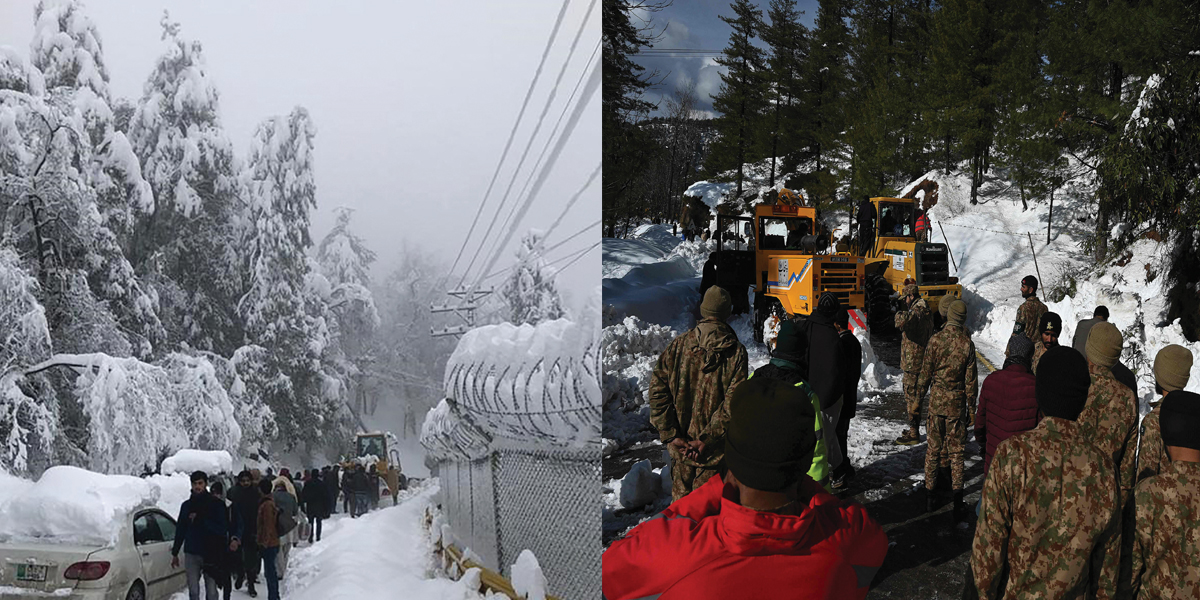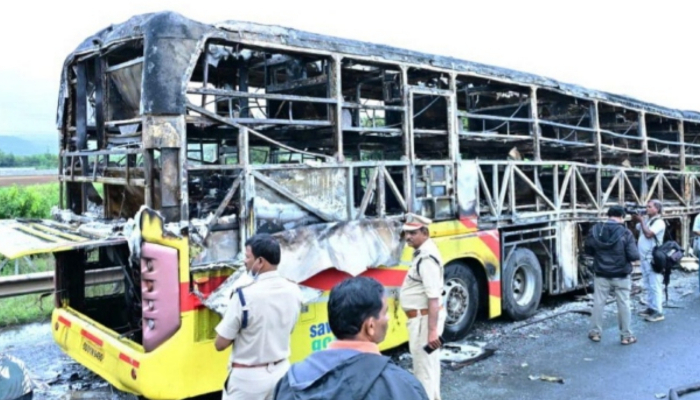For people across the world, resorts and hill stations are the best get-away destinations where they take solace from their year-round drills and tensions of workplace to enjoy a good vacation. But the recent ghastly incident at Murree, which took 22 lives, jolted the entire Pakistan while brutally exposing the downside of having a sojourn or a vacation at such resorts and how it can turn into a fatal nightmare for the tourists.
Needless to say, the incident has triggered insurrection from all quarters. People are angry, sad and restless and have demanded a thorough inquiry into the unfortunate incident and wants the culprits exposed and punished at the earliest. The Islamabad High Court Chief Justice has now directed the Prime Minister and the National Disaster Management Authority’s high ups to fix responsibility of the Murree disaster so that the culprits could be penalised.
Following the catastrophe, Prime Minister Imran Khan, Chief Minister Punjab Usman Buzdar and many others in the echelons of power sprung into action and both Army and FWO were called in for rescue operation and evacuation of those trapped in Murree and its adjoining areas. As is customary after such disasters, an inquiry into the incident was also ordered.
Murree Hills, some 45 kilometres from Islamabad and a gateway to Galliat and Azad Kashmir, is a small town with a capacity to host a few thousand tourists at a time. However, with the improved road infrastructure and its close proximity with twin-cities of Rawalpindi and Islamabad, it is forever flooded with tourists in both summer and winter, especially in the days when there is snowfall in the area.
However, the harsh truth is that the Murree Hills is on verge of a series of environmental and human disasters, primarily owing to sheer neglect of the authorities responsible for the management of this famous hill station. The area has been subjected to mushroom growth of planned and unplanned construction with no proper infrastructure like sewerage system, provision of water and other civic facilities in place
Bol News decided to probe the reasons of the catastrophe which resulted in the deaths of 22 tourists on January 8 (Saturday) after hundreds of people remained stuck in the snow storm. Most of the deaths were reported in the area some five kilometer from Murree city but the local administration was nowhere to be seen during the entire period.
According to the residents of Kuldana area near Murree, the main traffic bottleneck point, which mainly led to the overall blockade of traffic on roads leading to Nathia Gali, Jhika Gali and Sanni Bank, could not be cleared of heavy snowfall because the machinery to clear snow from roads was not available at the point. Normally, the machinery was moved here at Kuldana Chowk before the snowfall, but since it was parked somewhere else, it could not be moved to the place of blockade.
Secondly, a huge number of vehicles simultaneously rushed to Murree from Nathia Gali side when snowfall started there which created a mess-up and lot of commotion at the Kuldana Chowk, resulting in the long queues of cars on all three sides converging at the point. According to the traffic police statistics, around 125000 to 130000 vehicles entered into Murree from Rawalpindi and Islamabad side on the day.
Despite that, the local administration took the matter lightly, altogether ignoring the severity of the snowstorm due to which temperatures dropped to minus six degrees Celsius. Had they timely responded to the situation, the lives of those who died in their vehicles either due to excessive carbon monoxide generating inside their vehicles or by hypothermia – could be saved.
Feroze Ali, a resident of Murree, said the deaths mainly occurred in the thick forest between Jikha Gali and Kuldana, hardly a few kilometers from main Murree.
“Had the administration been vigilant and called in the armed forces for help on Saturday night, the disaster could be averted to a great extent. The Army would have easily moved the stranded people to the nearby Army establishments and at other places in Murree,” said the residents of the area said.
As the traffic was jammed up to several kilometers in and outside Murree, the residents of the nearby localities did help some of the stranded people and provided them with food and quilts. But, obviously, all of those struck up in the traffic mess could not be provided with relief goods by public alone.
It is also interesting to note that the Metrological department had given a timely alert about the snowstorm. So why did the authorities ignore it and why preventive measures were not taken is an aspect which needs to be deeply investigated. The traffic police and administration should have taken preventive measures and should not have allowed the vehicles in such a huge number to proceed to the hill resort. They should have restricted the people from going to Murree the way they used to restrict them during the Eid holidays, when people from both Punjab and Khyber-Pakhtunkhawa used to flood the hill resorts.
Having said that, the people who recklessly headed for Murree sans any planning could not be absolved of their attitude that led to the disaster. They, too, should have taken notice of the snowstorm alert by metrological department and deferred their visits, especially when the traffic police was also cautioning them on loudspeakers at various points not to proceed to the hill resort owing to the massive traffic jams ahead.
It was further reported that after witnessing the traffic jam on the Murree Expressway, the motorists tried to move forward through the wrong side which caused a lot of chaos among the drivers.
Besides the high-level inquiry into the matter, ordered by Prime Minister Imran Khan, Chief Minister Punjab Sardar Usman Buzdar has also a number of measures including upgrading of Murree Tehsil to the level of district so that a full-fledged district administration set up could be available to deal with the growing issues confronting the hill resort in an efficient manner.
With the nomenclature Murree Tourist District, the new district would comprise Murree and Kotli Sattian areas alone and not include the other areas of Kahuta and Kalar Syedan which will remain part of Rawalpindi.
But such steps will not entirely solve the problem at hand. Unless the government address the real issues facing the hill resort, the impending perils of disasters facing the Murree Hills would remain.
According to a report prepared by International Union for Conservation of Nature (IUCN) on the environmental threats to the hill resort, it was noted that growing concrete structures were posing serious threat to the overall eco-system in the area besides increasing the threat of some major disaster, because the topography of the area could not withstand the huge concrete structure.
It was further noted that in most of the cases the building by-laws were violated.
This report was prepared some 10 years back and, over the last one decade, numerous multi-story buildings had been erected in Murree and its adjoining areas posing serious environmental issues.
Previously, during the government of ex-premier Mian Nawaz Sharif, the construction of hotels and huge buildings on both sides of Murree Expressway had been banned. However, over the past three years people have constructed huge buildings on both sides of the expressway, in connivance with the concerned authorities.
As the area falls on the seismically active zone, so the chances of a major disaster could not be ruled out.
Realizing the gravity of the situation, the Punjab Government had prepared new building by-laws in October last year, restricting people from constructing multi-storey buildings. Only buildings with ground plus two, with a maximum height of 38 feet, are allowed under the new laws.
But the issue is not with the laws but its implementation as over 90 percent of buildings in Murree have been constructed in sheer violation of the by-laws.
Similarly, majority of the commercial and residential buildings in Murree and its adjoining areas were not having proper sewerage system and, one way or the other, the sewerage waste was going down the water streams or let open in the rainwater nullahs and tributaries.
A new practice adopted by some of the residents of Murree is sinking of tube-wells, which according to environmental experts, would drain the mountains of the water and result in turning the whole area barren. But interestingly, the national civic body has turned a blind eye to this practice going on in the area.
The municipal authorities in Murree were also not having a proper garbage collection and disposal system in place due to which one can see shopping bags and garbage littered along the main roads and on the hills slopes.
All these things would be ruining not only the topography of the area but will be posing serious threats to the overall ecological system in Murree as well for people living in adjoining areas.
Of course, the biggest responsibility in the tragic incident lies with the National Disaster Management Authority (NDMA) which has its head office in Islamabad. Prime Minister Imran Khan as well as Minister for Planning and Development Asad Umar have often praised the efficiency and working of the NDMA. They should now be steadfastly taking the NDMA to task for its criminal negligence on the Murree disaster in order to set an example for the other such organisations.
Besides, there is also a Disaster Commission which reports directly to the PM on such matters, but was sadly found missing in action on Saturday.
There are definite lesson to be learnt from the Murree tragedy and practical steps need to taken on a war footing instead of holding long meetings and forming committees and preparing reports which will contribute nothing in avoiding a recurrence of such an unfortunate incident.
Keeping in view the huge influx of the tourists in the area, the government should take adequate measures to spruce up the infrastructure and enhancement of facilities to cater to the needs of the tourists and ensure that the disaster management organisations have latest and efficient equipment and staff in place to reach the distressed people in a matter of minutes, not days.

















